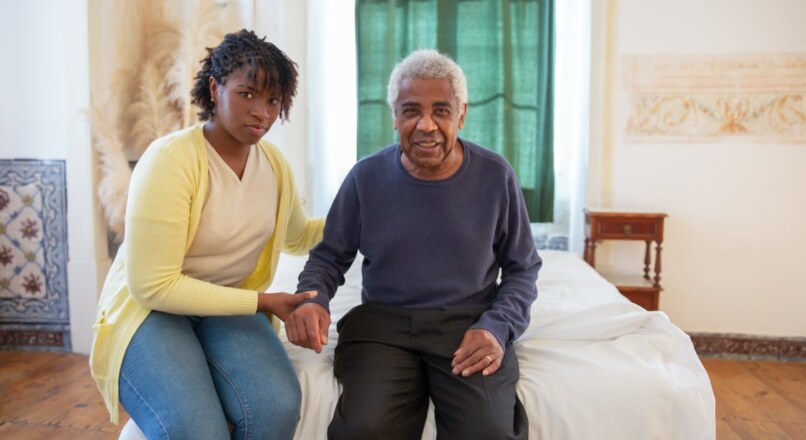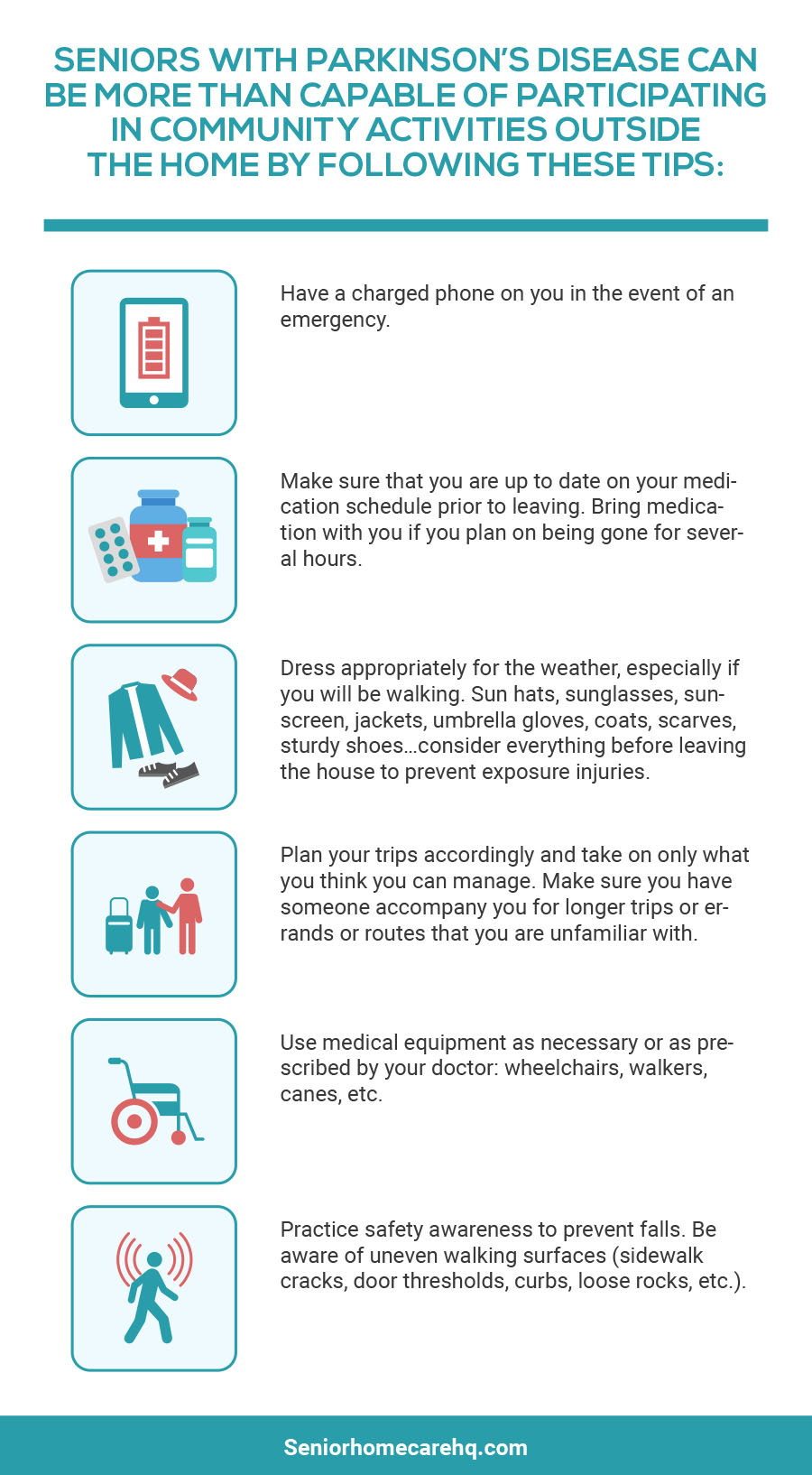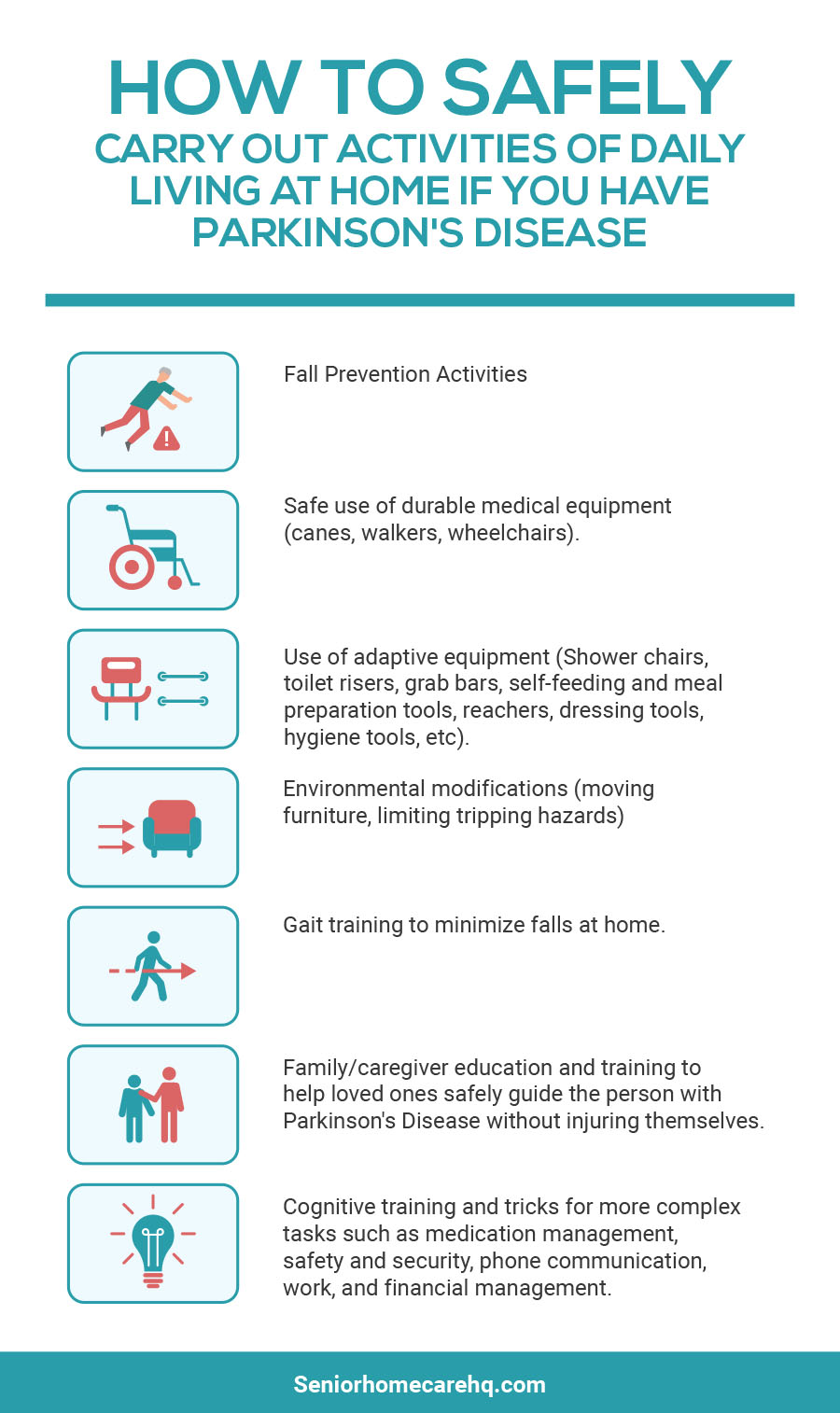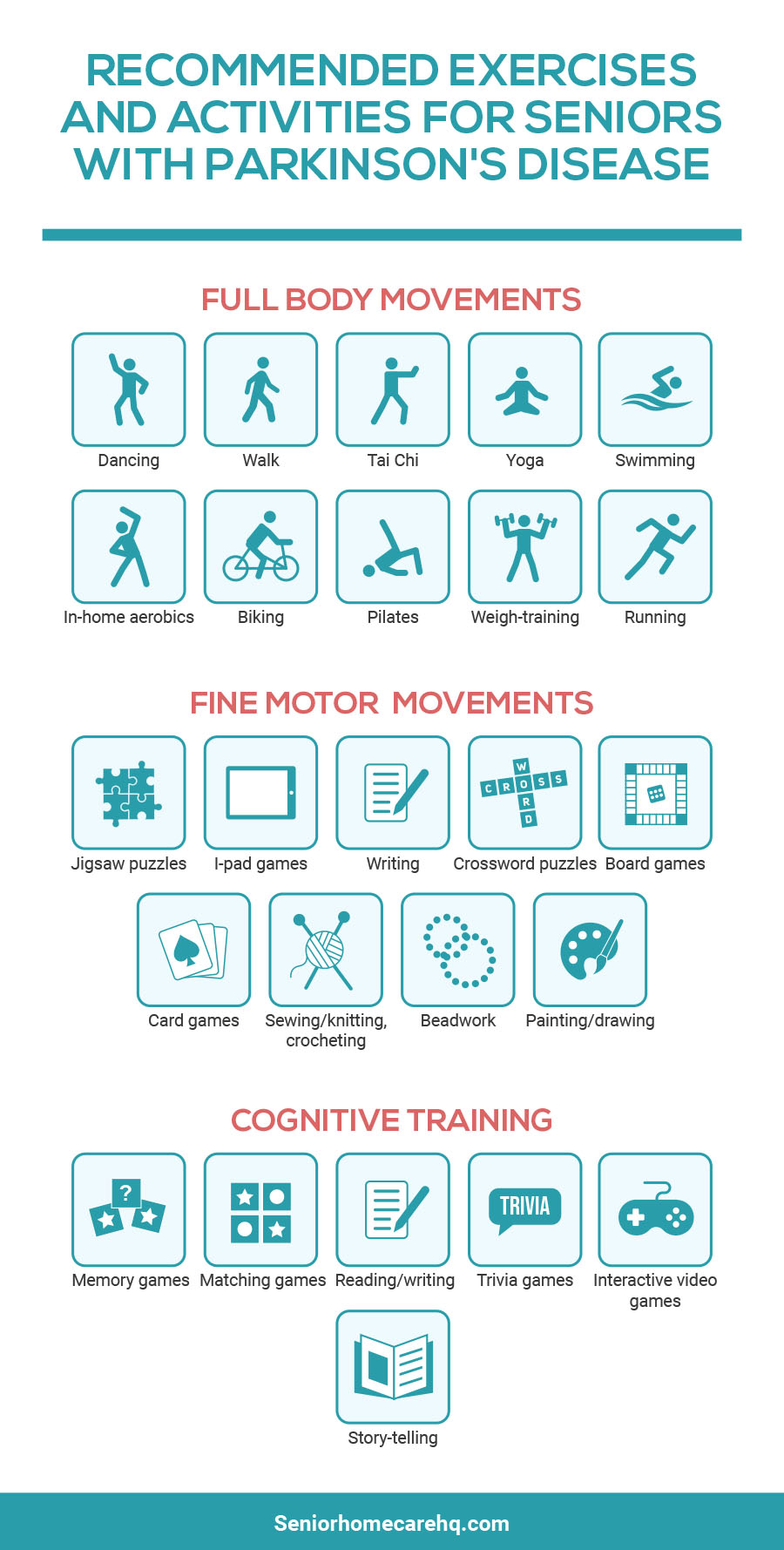
Best Tips For Caregivers To Help Seniors Manage Parkinson’s Disease at Home
Last Modified [last-modified]
[su_highlight]Best Tips For Caregivers To Help Seniors Manage Parkinson’s Disease at Home[/su_highlight]
We are going to highlight some of the best tips for caregivers taking care of seniors with Parkinson’s disease.
Parkinson’s disease is a neurological disorder that can present with debilitating symptoms that completely alter a senior’s way of living and carrying out functional tasks.
We are going to discuss basic information about what Parkinson’s disease entails, how it’s treated, and the best tips for caregivers ( family members) and seniors to modify their lifestyles and adopt exercises that will help minimize symptoms and improve overall living.
[su_highlight]What is Parkinson’s disease (PD)?[/su_highlight]
Parkinson’s Disease is a brain disorder which impacts dopamine-producing neurons. Neurons are the cells that make up brain tissue, and there are millions upon millions located in one human brain.
Dopamine is a neurotransmitter responsible for multiple purposes: emotion, memory, motivation, and coordination of movement.
There are four classic signs of Parkinson’s Disease, of which people will exhibit all or some of:
- [su_service title=”Bradykinesia or slowing of movement” icon=”icon: check” icon_color=”#5d7ffa”][/su_service]
- [su_service title=”Limb rigidity, or rigid movements of the arms and legs” icon=”icon: check” icon_color=”#5d7ffa”][/su_service]
- [su_service title=”Tremors, or involuntary shaking” icon=”icon: check” icon_color=”#5d7ffa”][/su_service]
- [su_service title=”Walking and balance problems (Parkinson’s Foundation, 2021)” icon=”icon: check” icon_color=”#5d7ffa”][/su_service]
There are several types of Parkinson’s Disease, some which may not display the 4 classic signs consistently.
For example, Lewy bodies dementia will present with Parkinson-like symptoms as well as serious cognitive deterioration, such as seen in Alzheimer’s disease.
The cause of Parkinson’s Disease is primarily unknown, but researchers have made links to genetic and environmental causes.
[su_highlight]How is Parkinson’s Disease Treated in The Elderly?[/su_highlight]
There are multiple treatment avenues for Parkinson’s Disease, depending on the symptoms and severity of the disorder.
In the early stages, doctors may introduce dopamine-based medication such as Levadopa which helps minimize movement irregularities.
In advanced stages where medication is no longer working, physicians may suggest more invasive procedures such as neurosurgery.
[su_highlight]What is The Best Way to Perform Activities of Daily Living at Home If You Have Parkinson’s Disease?[/su_highlight]
Aside from pharmacological treatments, clinicians will also suggest rehabilitative and lifestyle interventions to be used regularly at home.
Physical and occupational therapists will make several suggestions on how to safely carry out activities of daily living (ADLs) at home, including some of the following:
- [su_service title=”Fall prevention activities.” icon=”icon: certificate” icon_color=”#5d7ffa”][/su_service]
- [su_service title=”Safe use of durable medical equipment (canes, walkers, wheelchairs).” icon=”icon: certificate” icon_color=”#5d7ffa”][/su_service]
- [su_service title=”Use of adaptive equipment (Shower chairs, toilet risers, grab bars, self-feeding and meal preparation tools, reachers, dressing tools, hygiene tools, etc).” icon=”icon: certificate” icon_color=”#5d7ffa”][/su_service]
- [su_service title=”Environmental modifications (moving furniture and limiting tripping hazards).” icon=”icon: certificate” icon_color=”#5d7ffa”][/su_service]
- [su_service title=”Gait training to minimize falls at home.” icon=”icon: certificate” icon_color=”#5d7ffa”][/su_service]
- [su_service title=”Family/caregiver education and training to help loved ones safely guide the person with PD without injuring themselves.” icon=”icon: certificate” icon_color=”#5d7ffa”][/su_service]
- [su_service title=”Cognitive training and tricks for more complex tasks such as medication management, safety and security, phone communication, work, and financial management.” icon=”icon: certificate” icon_color=”#5d7ffa”][/su_service]
The best ways to perform ADLs at home is in the safest manner possible.
This includes keeping up on regular medication schedules, using medical equipment when necessary, and having a loved one around if a senior would like to attempt more complex tasks on their own.
[su_highlight]What Things Should You Avoid or Prevent While Performing Activities at Home with Parkinson’s Disease?[/su_highlight]
One of the most important things to avoid is falling in the home, especially while alone and with no way to contact others for help.
If a senior with Parkinson’s Disease would like to participate in a task that could compromise their balance (i.e climbing the stairs, watering the lawn, doing household tasks in standing, participating in bathroom tasks on slippery floors, etc.), make sure that a loved one is around for close supervision just in case an emergency occurs.
Make sure that a senior with Parkinson’s Disease always has access to help, even if it’s by phone or by a fall alarm system.
Additionally, make sure that the senior has the cognitive, visual, and auditory capacity to use the emergency communication system if a medical emergency in their home occurs.
[su_highlight]What Are The Recommended Exercises and Activities For Seniors with Parkinson’s Disease?[/su_highlight]
Parkinson’s disease should not be considered a life sentence in which a senior is completely restricted in their movement for fear of falling.
If anything, seniors with Parkinson’s disease should be taking every opportunity to move in the safest manners as possible. Which includes stretching, correcting posture and improving balance in standing positions.
Some of the following exercises and activities have proven to be effective for seniors with Parkinson’s disease .
[su_service title=”Full Body Movements:” icon=”icon: play” icon_color=”#5d7ffa”][/su_service]
- Dancing
- Walks
- Tai Chi
- Yoga
- Swimming
- In-home aerobics
- Biking
- Pilates
- Weight-training
- Running
[su_service title=”Fine Motor Movements:” icon=”icon: play” icon_color=”#5d7ffa”][/su_service]
- Jigsaw puzzles
- I-Pad games
- Writing
- Crossword puzzles
- Board games
- Card games
- Sewing/knitting, crocheting
- Beadwork
- Painting/drawing
[su_service title=”Cognitive Training” icon=”icon: play” icon_color=”#5d7ffa”][/su_service]
- Memory games
- Matching games
- Reading/writing
- Trivia games
- Interactive video games
- Story-telling
There’s not a “one-size fits all” exercise regimen for every senior with Parkinson’s disease .
Choose the exercises and activities that pique your interest and work within your capabilities and goals.
Consult with a doctor if you have any questions about participating in physically intense exercises.
[su_highlight]What Are Some Recommended Tips for Community Participation While Living with Parkinson’s Disease?[/su_highlight]

Again, Parkinson’s disease should not be treated as a life sentence so that seniors are unable to leave their homes.
Seniors with Parkinson’s disease can be more than capable of participating in community activities outside the home.
Depending on the severity of the symptoms and the type of Parkinson’s disease , each senior should consider the following tips and precautions before leaving the house:
- [su_service title=”Have a charged phone on you in the event of an emergency.” icon=”icon: hand-o-right” icon_color=”#5d7ffa”][/su_service]
- [su_service title=”Make sure that you are up to date on your medication schedule prior to leaving. Bring medication with you if you plan on being gone for several hours.Make sure that you are up to date on your medication schedule prior to leaving. Bring medication with you if you plan on being gone for several hours.” icon=”icon: hand-o-right” icon_color=”#5d7ffa”][/su_service]
- [su_service title=”Dress appropriately for the weather, especially if you will be walking. Sun hats, sunglasses, sunscreen, jackets, umbrella gloves, coats, scarves, sturdy shoes…consider everything before leaving the house to prevent exposure injuries.” icon=”icon: hand-o-right” icon_color=”#5d7ffa”][/su_service]
- [su_service title=”Plan your trips accordingly and take on only what you think you can manage. Make sure you have someone accompany you for longer trips or errands or routes that you are unfamiliar with.” icon=”icon: hand-o-right” icon_color=”#5d7ffa”][/su_service]
- [su_service title=”Use medical equipment as necessary or as prescribed by your doctor: wheelchairs, walkers, canes, etc.” icon=”icon: hand-o-right” icon_color=”#5d7ffa”][/su_service]
- [su_service title=”Practice safety awareness to prevent falls. Be aware of uneven walking surfaces (sidewalk cracks, door thresholds, curbs, loose rocks, etc.).” icon=”icon: hand-o-right” icon_color=”#5d7ffa”][/su_service]
Closing Thoughts on The Best Tips for Caregivers Helping Seniors Manage Parkinson’s Disease At Home
Seniors living with Parkinson’s disease face many obstacles due to physical (and sometimes cognitive) symptoms that accompany the disorder.
However, with the right approach and lifestyle adjustments, seniors with Parkinson’s disease can thrive just as well as their peers (if not better) who do not have Parkinson’s disease .
Stay updated on your medical management with a primary physician. Attend regular rehabilitative services (occupational and physical therapy).
Accept help from family and loved ones when you need it. Make your safety and wellness a high priority in everything you do, and you can maintain a high quality of life.
References
What is Parkinson’s? (2021). Parkinson’s Foundation. https://www.parkinson.org/understanding-parkinsons/what-is-parkinsons. Viewed on May 27, 2021.



Comment ( 1 )
My husband has Parkinson’s disease, he is about 63 years old it was diagnosed 2 years ago. It was getting more difficult to live for him, because of stiff muscles he couldn’t even move. Mirapex and levodopa medicines were given, but didn’t give much relief. He couldn’t eat food without choking. I thought this might be the last stage and the medications he was given did not help at all, so I started to do alot of research on Ayurveda treatments, I was introduced to Health Natural Centre and their Parkinson’s Ayurveda Protocol. He started on the Ayurveda Treatment last year, his symptoms gradually diminished including his vocal cord spasm, Muscle Weakness, Tremors and Difficulty with swallowing. Reach them at natural herbs centre . com , he is getting active again since starting this treatment, he is able to walk again ( down the street and back ) he has also resumed exercising to strengthen muscles!! God Bless all PD Caregivers. Stay Strong, take small moments throughout the day to thank yourself, to love your self, and pray to whatever faith, star, spiritual force you believe in and ask for strength. I can personally vouch for these remedy but you would probably need to decide what works best for you.